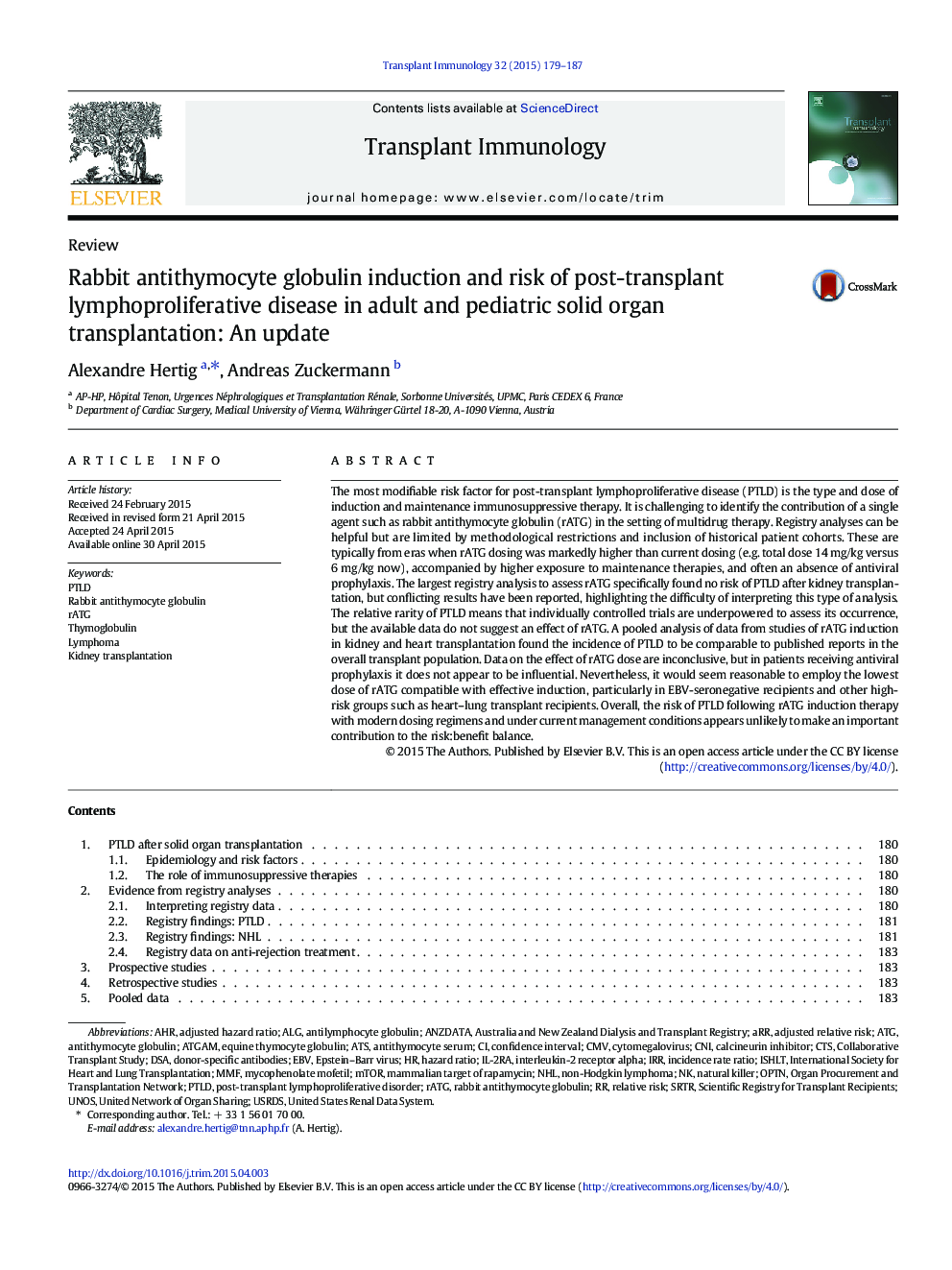| کد مقاله | کد نشریه | سال انتشار | مقاله انگلیسی | نسخه تمام متن |
|---|---|---|---|---|
| 6125989 | 1221185 | 2015 | 9 صفحه PDF | دانلود رایگان |
عنوان انگلیسی مقاله ISI
Rabbit antithymocyte globulin induction and risk of post-transplant lymphoproliferative disease in adult and pediatric solid organ transplantation: An update
ترجمه فارسی عنوان
القاء آنتی تیماسسی گلوبولین خرگوش و خطر بیماری لنفوپرولیفراتیای پس از پیوند در پیوند عضو بدن بزرگسالان و کودکان: به روز رسانی
دانلود مقاله + سفارش ترجمه
دانلود مقاله ISI انگلیسی
رایگان برای ایرانیان
کلمات کلیدی
ATGNHLPTLDOPTNISHLTSRTRDSAIL-2RAATGAMATSCNIMMFRATGAHRIRRUSRDSAntilymphocyte globulinALGAntithymocyte serumANZDATAmTORARRCTSnatural killer - (سلول های) کشنده طبیعیdonor-specific antibodies - آنتی بادی اختصاصی اهدا کنندهRabbit antithymocyte globulin - آنتی تیموتیک گلوبولین خرگوشantithymocyte globulin - آنتیسموکسی گلوبولینPost-transplant lymphoproliferative disorder - اختلال لنفوپرولیفراتیای پس از پیوندInternational Society for Heart and Lung Transplantation - انجمن بین المللی پیوند قلب و ریهEBV - اپشتین بار ویروسThymoglobulin - تیموگلوبولینRelative risk - خطر نسبیAdjusted relative risk - خطر نسبی قابل تنظیمCMV - سیتومگالوویروسcytomegalovirus - سیتومگالوویروسUnited States Renal Data System - سیستم داده کلیه ایالات متحدهUnited Network of Organ Sharing - شبکه توزیع عضو ارگان متحدهOrgan Procurement and Transplantation Network - شبکه های ترویج و پیوند عضو بدنconfidence interval - فاصله اطمینانLymphoma - لنفومNon-Hodgkin lymphoma - لنفوم غیر هوچکینmycophenolate mofetil - مایکوفنولات موفتیلcalcineurin inhibitor - مهار کننده کالسینورینhazard ratio - نسبت خطرadjusted hazard ratio - نسبت خطر تنظیم شده استincidence rate ratio - نسبت میزان بروزmammalian target of rapamycin - هدف پستانداران رپامایسینEpstein–Barr virus - ویروس Epstein-BarrKidney transplantation - پیوند کلیهInterleukin-2 receptor alpha - گیرنده آلفای اینترلوکین-2UNOS - یونوس
موضوعات مرتبط
علوم زیستی و بیوفناوری
ایمنی شناسی و میکروب شناسی
ایمونولوژی
چکیده انگلیسی
The most modifiable risk factor for post-transplant lymphoproliferative disease (PTLD) is the type and dose of induction and maintenance immunosuppressive therapy. It is challenging to identify the contribution of a single agent such as rabbit antithymocyte globulin (rATG) in the setting of multidrug therapy. Registry analyses can be helpful but are limited by methodological restrictions and inclusion of historical patient cohorts. These are typically from eras when rATG dosing was markedly higher than current dosing (e.g. total dose 14Â mg/kg versus 6Â mg/kg now), accompanied by higher exposure to maintenance therapies, and often an absence of antiviral prophylaxis. The largest registry analysis to assess rATG specifically found no risk of PTLD after kidney transplantation, but conflicting results have been reported, highlighting the difficulty of interpreting this type of analysis. The relative rarity of PTLD means that individually controlled trials are underpowered to assess its occurrence, but the available data do not suggest an effect of rATG. A pooled analysis of data from studies of rATG induction in kidney and heart transplantation found the incidence of PTLD to be comparable to published reports in the overall transplant population. Data on the effect of rATG dose are inconclusive, but in patients receiving antiviral prophylaxis it does not appear to be influential. Nevertheless, it would seem reasonable to employ the lowest dose of rATG compatible with effective induction, particularly in EBV-seronegative recipients and other high-risk groups such as heart-lung transplant recipients. Overall, the risk of PTLD following rATG induction therapy with modern dosing regimens and under current management conditions appears unlikely to make an important contribution to the risk:benefit balance.
ناشر
Database: Elsevier - ScienceDirect (ساینس دایرکت)
Journal: Transplant Immunology - Volume 32, Issue 3, June 2015, Pages 179-187
Journal: Transplant Immunology - Volume 32, Issue 3, June 2015, Pages 179-187
نویسندگان
Alexandre Hertig, Andreas Zuckermann,
